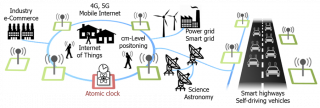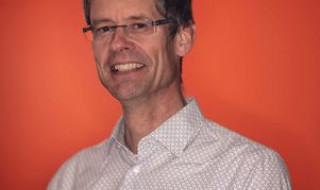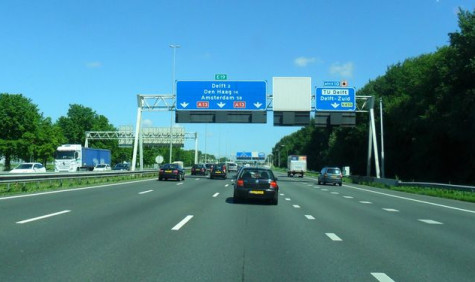SuperGPS
Super-precise positioning via optical network
GPS is good at positioning in large open spaces without obstacles, such as oceans and deserts. But in urban areas, with all its tall buildings, accurate positioning with satellite signals is more difficult. SuperGPS opts for a different solution: a combination of an optical fibre network and radio transmitters on buildings and along streets.
Key facts
Who: Christian Tiberius
Position: associate professor
Organisation: TU Delft
Challenge: GPS is unreliable in urban areas due to signal reflections, which is problematic for applications such as self-driving cars.
Solution: SuperGPS uses an optical network coupled to an atomic clock and radio transmitters along roads to locate vehicles to within 1-2 decimetres.
Christian Tiberius is associate professor at TU Delft's Faculty of Civil Engineering. From that position, he is one of the project leaders of SuperGPS. "We started this project in 2016, in collaboration with the VU, where Jeroen Koelemeij was already doing a lot of work on time and frequency distribution over fibre. We already had a lot of knowledge about using broadband radio signals. We were able to combine these two areas of expertise nicely. Meanwhile, the project is entirely in our hands, and I lead it together with colleague Gerard Janssen of Electrical Engineering."

SuperGPS - The fibre-optic network, to which an atomic clock is connected, is shown by the blue line. In the green boxes are the radio transmitters connected to the network. They transmit time signals wirelessly to, for example, self-driving cars. - image: TU Delft
Ships on oceans
The basic idea of SuperGPS is that you do not determine position with radio signals from satellites, but with a combination of an optical fibre network and radio transmitters on buildings and along streets. Tiberius explains the advantage of this. "The US defence once invented GPS for locating ships on oceans, military vehicles in the desert and aircraft in the sky. It works fine there too. Because there are hardly any obstacles, you always have direct visibility with the satellites. Meanwhile, consumers also use GPS for many applications, including navigation. And soon we will also need it for self-driving cars."
Self-driving cars and road safety
And in that application, you can see a disadvantage of GPS: especially in urban areas, there are a lot of obstacles. A GPS device then receives radio signals from satellites both directly and reflected via buildings. Consequence: the positioning sometimes deviates by hundreds of metres. Tiberius: "For navigation purposes, this is not so bad: your TomTom will correct this deviation, using the installed map. But if we want to do positioning for self-driving cars, it has to be a lot more accurate. Road safety is at stake here."
Atomic clock at VSL
SuperGPS manages to pinpoint the location of a vehicle to within 1-2 decimetres, enough to allow it to safely participate in traffic. How does that work? Tiberius: "The basis of SuperGPS is an optical network connected to an atomic clock (in our case, one from metrology institute VSL in Delft), which allows the network to transmit very precise time pulses. Transmitters are connected to that network. These stand along roads, or hang from buildings and send radio signals to the objects whose location you want to determine, in our case self-driving cars."
SURF, by extending its network, was instrumental in making the time distribution of VSL's atomic clock available to TU Delft for this technology. SURF also installed the equipment that communicates with the atomic clock and transmits the time pulses to radio transmitters located, for example, along the road, as shown in the picture.

Christiaan Tiberius
Accurate to 100 picoseconds
Meanwhile, experiments have been carried out with SuperGPS. Tiberius: "Many projects result in papers, articles or other documents. We said at the start: we really want to make this work practically. So we put it to the test in The Green Village - an existing experimental garden at TU Delft. We hung transmitter boxes on six lampposts. Each transmitter was connected to the fibre-optic network on which the atomic clock distributed time. We then drove a car equipped with a receiver and checked whether the system could determine the car's position accurately enough, i.e. to within 1 to 2 decimetres. It turned out to be so!
The optical network delivered VSL's timing signal to each radio station to within 100 picoseconds. The radio stations then broadcast their signals, which the car used to determine its position. A deviation of 100 picoseconds (1 picosecond = 1 trillionth of a second) corresponds to an error in the measured distance of 3 centimetres. However, there are other sources of error in the system (e.g. thermal noise in the electronics), so the accuracy ends up being 1 to 2 decimetres."
Serious interest
Of course, SuperGPS has no end users at the moment: it is currently a prototype, and then there is a long way to go before there is suitable equipment for the end user. But Tiberius does expect SuperGPS to be really deployed. "We have a large user committee at NWO, which funded the project, which includes large companies and institutes like KPN and TNO. That indicates that there is serious interest in SuperGPS."
